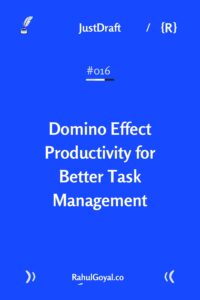Domino Effect Productivity for Better Task Management
Ever felt overwhelmed by the sheer number of tasks on your plate? Imagine if you could align them in a way that each task naturally flows into the next—like tipping over a row of dominoes. That’s the Domino Effect, a productivity method that helps you focus, build momentum, and complete tasks seamlessly.
One Topic: The Domino Effect
Core Idea: Build Momentum with Small Wins
The Domino Effect works on psychological momentum. By starting with smaller tasks, you engage your brain’s reward system. It’s like solving an easy puzzle piece before tackling the larger picture—it builds confidence and motivation.
How to Sequence Tasks Strategically
- Understand Task Interdependence – Map out which tasks rely on others. For instance, drafting a proposal may depend on prior research.
- Manage Your Energy – Tackle high-energy tasks early in the day when your focus is sharpest. Transition to easier tasks as your energy wanes.
- Leverage Visual Tools – Use tools like Trello or Notion to create a cascading workflow. A visual roadmap minimises decision fatigue.
Why Domino Effect Works
- Reduces Procrastination: You’re less likely to delay starting if the first task is manageable.
- Creates Flow: Each task feels like a natural progression, reducing the mental load.
- Boosts Confidence: Completing smaller steps builds the motivation to tackle bigger challenges.
Real-Life Example: Product Development
In software sprints, teams prioritize tasks like testing features before deploying them. Each task sets up the next one for success, ensuring smooth progress without backtracking.
Pro Tips to Maximise the Effect
- Experiment: Not all sequences work for everyone—trial and error will help.
- Review Often: Adjust your task order as priorities shift.
- Measure Progress: Track which sequences yield the best results.
With the Domino Effect, productivity isn’t about doing more; it’s about doing things in the right order.
Read last week’s JustDraft newsletter about the The Eisenhower Matrix.
Two Quotes
Small actions done strategically create the biggest ripple effects.
The key to productivity isn’t speed but sequence.
One Passage From A Book
Habits are the compound interest of self-improvement. The same way that money multiplies through compound interest, the effects of your habits multiply as you repeat them. They seem to make little difference on any given day, yet the impact they deliver over months or years can be enormous. It’s only when looking back two, five, or perhaps ten years later that the value of good habits and the cost of bad ones becomes strikingly apparent.
📚From “Atomic Habits” by James Clear

